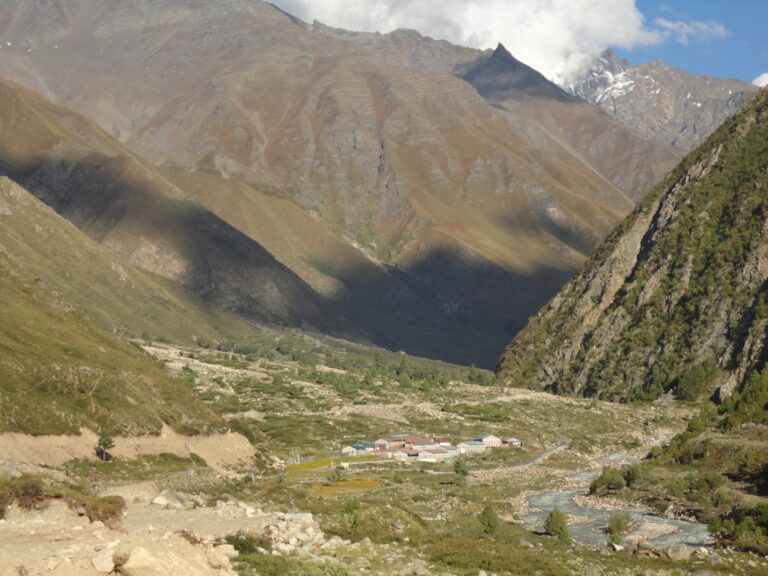Project Description
The Hindu Kush-Himalaya (HKH) mountains contain enormous freshwater reservoirs in the form of snow, glaciers, lakes, permafrost, and wetlands supporting a population of ⁓1.3 billion people [1,2]. The HKH harbours ⁓50% (by area) of all the world’s glaciers outside the polar regions. These are particularly sensitive to minor changes in temperature and precipitation due to their latitudinal position, high ablation rates and limited accumulation processes, making the downstream communities extremely vulnerable [1]. These marginalised communities are primarily dependent on subsistence agriculture for livelihood. The rising temperature and frequency, and intensity of extreme precipitation events and derived flooding and landslides, have stressed the agriculture-based economy forcing the communities to migrate to urban areas [3].
To assess this, and improve predictions for the future, which would be relevant to the water management authorities and policy maker, we will focus on two regions within the HKH, belonging to different contrasting climate zones. The Baspa Valley, India, is influenced by both the Indian Summer Monsoon (ISM) and the winter Western Disturbances (WD) [3] and is frequently affected by flash floods and landslides, destroying crops and property, disrupting transportation and, in some cases, claiming human lives. The Zanskar Valley in Ladakh, India, receives significantly less precipitation than Baspa. The communities living in Zanskar are often contended with irregular weather patterns and events. The frequency and intensity of these events have increased significantly over recent times. To fully understand this, and assess its impact on the local out migration, this project will undertake hydrological, land-use and demographic investigation of the Baspa and Zanskar Basin.
This project will be delivered through three interdisciplinary objectives: (1) Long-term discharge from both basins will be reconstructed using a well-calibrated and validated temperature index glacio-hydrological model. The reconstructed discharge data will be investigated for the peak and lowest discharge events and the main driver(s). (2) Assessment of the change in land-use for agricultural purposes using the records from Panchayats and Buddhist monasteries, which will be complemented by high-resolution land-use land-cover data from satellite images. (3) Analysis of the demographic data from national censuses and local government agencies to quantify the seasonal and permanent out migration from sampled villages. This will be accompanied with questionnaire/interview-based surveys in sampled villages to identify the factors responsible for out migration which will be complemented by the outputs from Objectives 1 and 2.
Besides the obvious relevance of this effort for the two specific regions and their inhabitants, the model implemented and perfectioned here, and its application to understand land-use and migration patterns, will become an ideal tool for the assessment of the effect of climate change on water availability and its implication for the local communities across the HKH and beyond.
CANDIDATE BACKGROUND
- A background in geography/environmental sciences
- An understanding of glaciers and climate change and associated impacts on local communities
- Essential qualification: Working knowledge of geographical information system (GIS)
- Desirable qualification: Experience of field work in high-altitude region
Photo credit: Shaktiman Singh, UOA
Supervisors
Shaktiman SinghPrimary Supervisor: | Profile: Shaktiman Singh Email: shaktiman.singh@abdn.ac.uk Institution: University of Aberdeen Department/School: School of Geosciences |
Donal MullanSecondary Supervisor: | Profile: Donal Mullan Email: D.Mullan@qub.ac.uk Institution: Queen's University, Belfast Department/School: School of Natural and Built Environment |
Matteo SpagnoloAdditional Supervisor: | Profile: Matteo Spagnolo Email: m.spagnolo@abdn.ac.uk Institution: University of Aberdeen Department/School: School of Geosciences |
Additional Supervisor: | Dr. Martin Mills |
References
[1] Immerzeel et al., 2010 https://doi.org/10.1126/science.1183188
[2] Singh et al., 2016 https://doi.org/10.1002/wcc.393
[3] Tiwari and Joshi, 2016 https://doi.org/10.1515/cass-2015-0002
QUADRAT Themes
- earth-systems
- environmental-management






















































